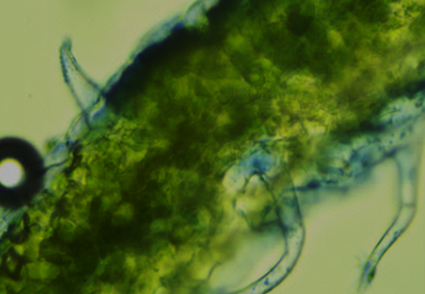Abstract
Mentha choujunensis (Lamiaceae), a new species from Suru valley of district Kargil in Ladakh, Trans-Himalaya, India is described here. The new species can be distinguished from its closest congeneric M. longifolia in possessing prostate stem, leaves petiolate and ovate to ovate-lanceolate, sparsely pubescent, trichomes 1-celled on adaxial side and 2-celled on abaxial side, base oblique, margin serrate, calyx less than half the length of corolla tube, 8–10 veined, calyx teeth reddish brown with distal trichomes 3–4 celled long and corolla white. Photo-illustrations, comparison of diagnostic characters of the new species with M. longifolia and taxonomic key for the Indian species under section Mentha are provided to facilitate field identification.
References
- Bentham, G. (1830) In: Wallich, N. (Ed.) Plantae Asiaticae Rariores, vol. 1. pp. 29.
- Bridson, D. & Forman, L. (1998) The herbarium handbook. Royal Botanic Gardens, Kew. Richmond, Surrey, United Kingdom. 261 pp.
- Briquet, J. (1897) Mentha longifolia subsp. royleana. In: Nat. Pflanzenfam. [Engler & Prantl]. 4 (3a): 322.
- Casella, F., Vurro, M., Valerio, F., Perrino, E.V., Mezzapesa, G.N. & Boari, A. (2023) Phytotoxic Effects of Essential Oils from Six Lamiaceae Species. Agronomy 13: 257. https://doi.org/10.3390/agronomy13010257
- Heylen, O.C.G., Debortoli, N., Marescaux, J. & Olofsson, J.K. (2021) A revised phylogeny of the Mentha spicata Clade reveals cryptic species. Plants 10: 819. https://doi.org/10.3390/plants10040819
- Hooker, J.D. (1885) The Flora of British India. Vol. 4. Reeve & Co., London.
- Kachroo, P., Sapru, B.L. & Dhar, U. (1977) Flora of Ladakh. An Ecological and Taxonomical Appraisal. Bishen Singh Mahendra Pal Singh, Dehradun.
- Kapp, K. (2015) Polyphenolic and essential oil composition of Mentha and their antimicrobial effect. Ph. D thesis. University of Helsinki, Finland.
- Klimeš, L. & Dickoré, W.B. (2006) Flora of Ladakh (Jammu and Kashmir, India)-a preliminary checklist. Available from: http://www.butbn.cas.cz/klimes (accessed 2 December 2022)
- Linnaeus, C. (1753) Species Plantarum. Ray Society, London, 576 pp.
- Linnaeus, C. (1759) Amoenitates Academici seu dissertationes variae physicae, medicae. ed. 4. Linnaeus, pp. 485.
- Mamadalieva, N.Z., Hussain, H. & Xiao, J. (2020) Recent Advances in Genus Mentha: Phytochemistry, Antimicrobial Effects, and Food Applications. Food Frontiers 1 (4): 435–458. https://doi.org/10.1002/fft2.53
- Mukerjee, S.K. (1938) A revision of the Labiatae of the Indian Empire. University of Edinburgh Press.
- POWO (2024) Plants of the World Online. Facilitated by the Royal Botanic Gardens, Kew. Available from: http://www.plantsoftheworldonline.org/ (accessed 10 September 2024)
- Rechinger, K.H. (1982) Labiatae. In: Rechinger, K.H. (Ed.) Flora Iranica. Academische Drucku Verlagsanstalt, Graz-Austria 150: 403–476.
- Šarić-Kundalić, B., Fialová, S., Dobeš, C., Ölzant, S., Tekeľová, D., Grančai, D., Reznicek, G. & Saukel, J. (2009) Multivariate Numerical Taxonomy of Mentha Species, Hybrids, Varieties and Cultivars. Scientia Pharmaceutica 77: 851–876. https://doi.org/10.3797/scipharm.0905-10
- Shinwari, Z.K. & Chaudheri, M.N. (1992) Taxonomic revision of genus Mentha from Pakistan Acta Phytotax. Geobot 43 (2): 97–110.
- Shukla, A.N. & Srivastava, S.K. (2020) Flora of Ladakh: An Annotated Inventory of Flowering Plants. In: Dar, G. & Khuroo, A. (Eds.) Biodiversity of the Himalaya: Jammu and Kashmir State. Topics in Biodiversity and Conservation, vol. 18. Springer, Singapore, pp. 673–731. https://doi.org/10.1007/978-981-32-9174-4_26
- Stewart, R.R. (1972) Flora of West Pakistan. An annotated catalogue of the vascular plants of West Pakistan and Kashmir. Fakhri Press, Karachi.
- Thiers, B. (2024) Index Herbariorum: a global directory of public herbaria and associated staff.
- Tucker, A.O. & Naczi, R.F.C. (2007) Mentha: An Overview of Its Classification and Relationships. In: Lawrence, B.M. (Ed.) Mint: The Genus Mentha. CRC Press: Boca Raton, FL, USA, pp. 1–40.
- Valerio, F., Mezzapesa, G.N., Ghannouchi, A., Mondelli, D., Logrieco, A.F. & Perrino, E.V. (2021) Characterization and antimicrobial properties of essential oils from four wild taxa of Lamiaceae family growing in Apulia. Agronomy 11: 1431. https://doi.org/10.3390/agronomy11071431
- Vining, K.J., Zhang, Q., Tucker, A.O., Smith, C. & Davis, T.M. (2005) Mentha longifolia (L.) L.: a model species for mint genetic research. HortScience 40 (5): 1225–1229. https://doi.org/10.21273/HORTSCI.40.5.1225
- Wallich, N. (1830) Plantae Asiaticae rariores, or, Descriptions and figures of a select number of unpublished East Indian plants. Vol. 1. Treuttel and Würtz, London, pp. 29. https://doi.org/10.5962/bhl.title.468
- Zargar, S.A., Ganie, A.H., Khuroo, A.A., Reshi, Z.A., Banoo, S. & Malik, A.H. (2023) An updated checklist of the vascular flora of the Trans-Himalayan region of Ladakh, India. Phytotaxa 623 (1): 1–136. https://doi.org/10.11646/phytotaxa.623.1.1


